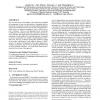SACMAT
2010
ACM
14 years 1 months ago
2010
ACM
Role mining from the existing permissions has been widely applied to aid the process of migrating to an RBAC system. While all permissions are treated evenly in previous approache...
SACMAT
2010
ACM
14 years 1 months ago
2010
ACM
Proposed models for spatially-aware extensions of role-based access control (RBAC) combine the administrative and security advantages of RBAC with the dynamic nature of mobile and...
SACMAT
2010
ACM
14 years 1 months ago
2010
ACM
The web is now being used as a general platform for hosting distributed applications like wikis, bulletin board messaging systems and collaborative editing environments. Data from...
SACMAT
2010
ACM
14 years 3 months ago
2010
ACM
There have been many approaches proposed for role mining. However, the problems solved often differ due to a lack of consensus on the formal definition of the role mining problem....
SACMAT
2010
ACM
14 years 7 months ago
2010
ACM
There has been increasing interest in automatic techniques for generating roles for role based access control, a process known as role mining. Most role mining approaches assume t...
SACMAT
2010
ACM
14 years 8 months ago
2010
ACM
SACMAT
2010
ACM
14 years 8 months ago
2010
ACM
We show the practical feasibility of monitoring complex security properties using a runtime monitoring approach for metric first-order temporal logic. In particular, we show how ...
SACMAT
2010
ACM
14 years 8 months ago
2010
ACM
We propose a new approach for applying Role-Based Access Control (RBAC) to methods in objects in the Java programming language. In our approach, a policy implementer (usually a de...
SACMAT
2010
ACM
14 years 8 months ago
2010
ACM
Policy authors typically reconcile several different mental models and goals, such as enabling collaboration, securing information, and conveying trust in colleagues. The data un...
SACMAT
2010
ACM
14 years 8 months ago
2010
ACM
The role-based access control (RBAC) has significantly simplified the management of users and permissions in computing systems. In dynamic environments, systems are usually unde...




